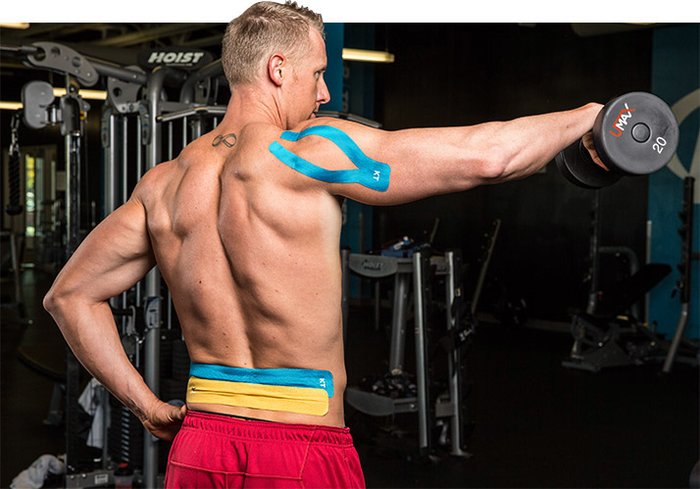
The use of Kinesio tape for physical therapy has been in practice since its innovation in the 1970s by Japanese Chiropractor Kinesio Kase. The treatment option is used if a person has suffered an injury or is dealing with a debilitating weakness that leads to mobility or motor function problems. Kinesio tape functions by applying strips of the specialized tape to your body in specific directions to support your muscles, tendons, and joints.
Dr. Kase was inspired to create the tape when a patient insisted on having to train for an upcoming competition despite being injured.The patient refused to take the proper rest and decided to forego traditional therapy.
Traditional care involved isolating the injury and forcing rest on the athlete. The forced time off would give the body sufficient time to bring down the swelling generated to protect the area, thus allowing the healing process to occur.
Dr. Kase decided to create kinesiology sports tape to scapegoat the extended amount of rest and allow the athlete to continue training while receiving the necessary support for the muscles and tendons in the injured area.
How Does Kinesiology Tape Work?
When used, kinesiology tape performs a variety of tasks. Your physical therapist will evaluate and assess before you begin using it to identify the optimal application of kinesiology tape. They will determine whether you need the tape at all, and then where and how to apply it. Athletes have to be evaluated to address the determining factors, especially the type of sports they engage in, to help determine the cause of injury and how kinesio tape can help.
Kinesiology tape is generally believed to aid in restoring balance to the neurological circuitry in muscles, tendons, joints, and skin. This is believed to work to lessen swelling and pain. It aims to enhance the functionality and performance of muscles.
In addition to aligning common postures, kinesiology tape is also known to be effective in managing scar tissue and modifying collagen structures. Another function of kinesio tape is to fight off fluid buildup and keep inflammation and swelling as minimal as possible.
When tissue gets inflamed from injury, blood flow is restricted, resulting in less oxygen reaching the injury. With the application of Kinesiology Tape, pressure is applied to the injury preventing fluid buildup and allowing blood to flow freely. This, in turn, allows more oxygen to reach so the body can heal itself.
Different explanations exist on how kinesiology tape functions. The proprioception input of the sensory nervous system in the muscles, joints, and skin is first hypothesized to be changed through the pressure of the tape. This sensation gives you the ability to locate your body in space. This sensational awareness is important for you. While practicing, it is important to use proper technique and train at a slightly easier intensity than usual.
In order to reset the circuitry of this area of the nervous system and increase the activation and function of the muscles, it is believed that the tape will improve the contact between the skin and the underlying tissues. Additionally, kinesiology tape inhibits nociceptors (pain pathways) in your muscles, skin, and joint structures. It is believed that reducing unpleasant input to the brain normalizes muscle tone, which reduces pain and muscle spasms.
While it may depend on the brand, several K-Tapes have a medicated non-steroidal pain medication mixed with the tape's adhesive. Other brands offer natural pain medication in the form of Menthol or Camphor to create a warm, soothing sensation to the injury.
What Does Kinesio Tape Do?
Although kinesiology tape resembles elastic athletic tape, there are some variances. These are a few of them:
- Athletic tape is used for support and to restrict motion, usually due to already present pain, whereas kinesiology tape is intended to facilitate motion and suppress pain and spasm.
- Athletic tape is often rigid, whereas kinesiology tape is fluid and moves with your movements. Improved circulation and lymphatic transfer are both benefits of kinesiology tape. The athletic tape has a tight-binding design that reduces circulation.
- Kinesiology tape is made up of cotton and an elastic polymer like nylon. The combination of the two allows for an elastic feature. The material can stretch and its natural ability to pull on itself while gripping the skin creates that space that is so desired to bring oxygen to the injury.
- Athletic tape in the past was used primarily to limit motion, and its inflexible nature made it unsuitable for continued training while injured. The tape would decrease the circulation of blood, causing the healing process to slow down instead of helping it reach its full potential.
Overall, K-tape is more flexible and efficient for usage injuries in athletes. The next step is to find a specific dressing pattern, which a medical professional will recommend. This dressing is different for each injured area.
K-Tape: Quick Application
- Wash and dry the skin.
- Shave excess hair around the area.
- Understand the application pattern and cut the strips of tape beforehand.
- Apply the tape to the skin in the desired pattern
- Rub the surface of the tape vigorously to activate the adhesive.
The tape's medicated adhesive is powerful. It is originally designed to stay on the body despite water or sweat. It will stay on the skin for up to five days. The tape comes in several colors and can be worn with day or evening wear if needed.
Numerous applications might be made depending on the situation and the injury. Your physical therapist may demonstrate how to apply the tape and shape the adhesive strips for the best results.
Different Types of Tape Cuts
The "I" strip: The other strips listed below can be created using this shape. I strips are typically used to support ligaments, tendons, and muscles. They frequently support your rotator cuff, gluteus muscles, quadriceps, or Achilles tendon. You can use them on your middle and low back to maintain good posture.
The "X" strip: It is utilized when kinesiology tape needs to cross several joints or a broad area. The "X" strip tabs cross over tender spots like the front or back of your elbows. This strip is frequently utilized to help your hamstrings, which pass through the back of your knee and the hip joint.
The "Y" strip: This strip is utilized to pass across delicate body parts like the area in front of your elbow or behind your knee. In cases of patellofemoral stress syndrome or subluxation of the patella, it is also frequently applied to manage the kneecap position. Usually, the "Y" strip is shorter than the "X."
The "fan" strip: This kind can assist in reducing arm or leg swelling. It is frequently used to treat superficial contusions, swelling, and lymphedema.
The "lift" strip: This strip, often known as the Band-Aid, is frequently used to support wounded tissues or to treat trigger points or muscle knots. It aids in removing skin, tissue, and trigger points from aching muscles. For treating superficial bruises, it is also employed.
You can make sure you're applying the tape in the right spot and that it's not excessively tight or restricting by consulting your therapist or a sports medicine professional. You'll be told how long to wear the kinesiology tape by them as well.
In conclusion, K-tape is very useful for people that want to continue working on their physical fitness and training whilst managing an injury. To properly utilize this important tool, consult a physical therapist or sports medicine professional before you begin to apply the tape on yourself.



